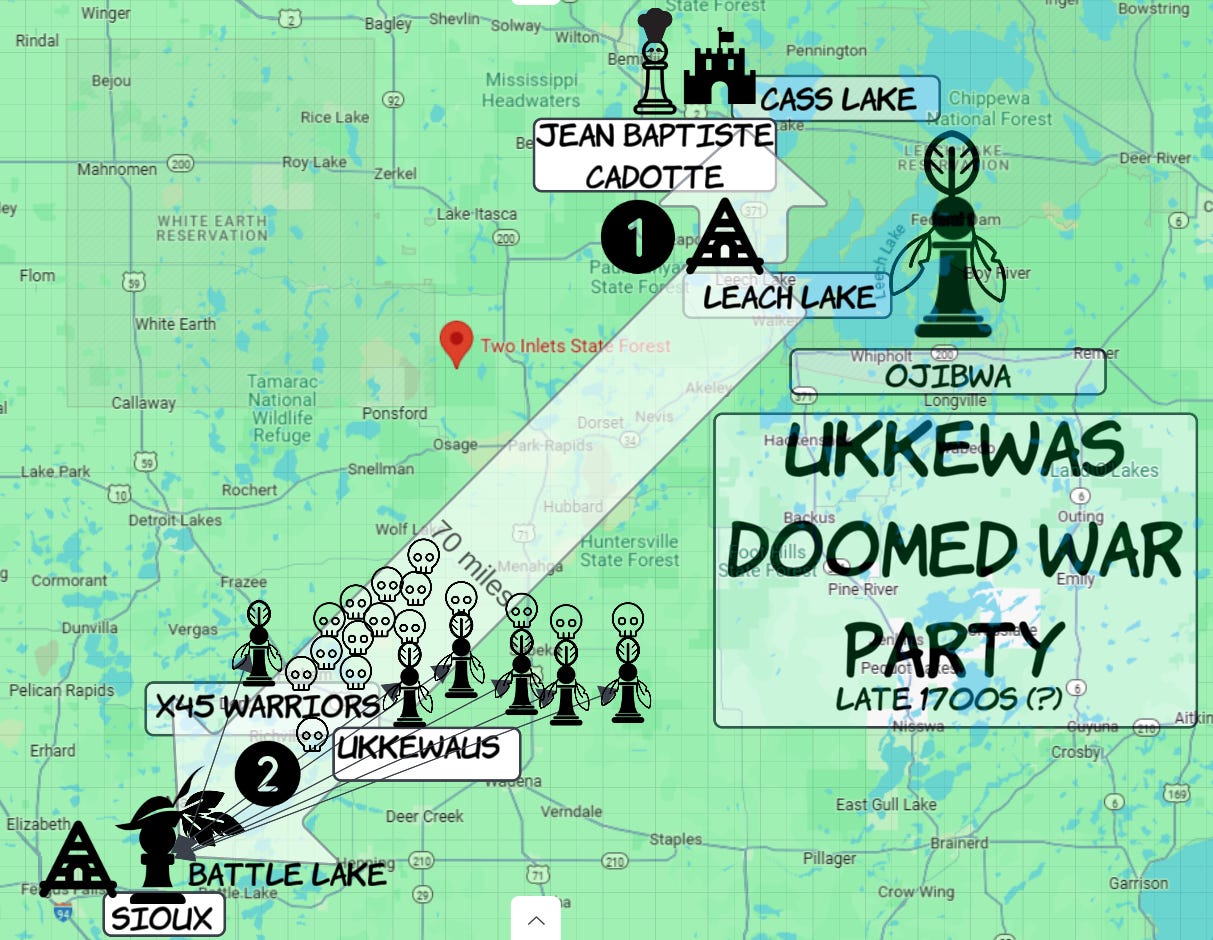Wound Around The Horn of Minnesota
Naval Power of North America Part III
Introduction
Parts I & II covered the French position on the horn of Minnesota and the region’s complicated political context at the time Pierre Verendrye arrived at Fort Charles in 1733.
This part will look at the pre-1733 historical context, how the situation came to be when Pierre landed at the remote barter town fort, then look some of the naval maneuvers in the battles of the Ojibwa’s rise to power.
Let’s start with a closer look at one tribe, the Winnebago, a tribe that established themselves as a regional power in modern day Wisconsin by 1732 by allying with the French.
This series may be red in its entirety by tag https://crackpot.substack.com/t/ojibwa
The Winnebago
[1] 200 A.D. ancestors of all the region’s tribes arrived. They became the Sioux.
[2] 700 A.D. a migratory band of Chiwere Sioux went north and became the Winnebago.
[3] 1614 A.D. the Winnebago encounter the first French traders and explorers.
[4] 1634-1640 - the nadir. Smallpox epidemics and wars with Algonquian speaking tribes to the northeast reduce the Winnebago from 25,000 persons to 100 people.
[5] 1687 - A recovered Winnebago align with the French in a victorious war against the British aligned Iroquois nation.
[6] 1701-1737 - The Winnebago cement ties with the French and Fox tribes in two separate wars from 1701-1716 and 1723-1737. These wars were fought to establish control over the fur trade and the Winnebago were again victors.
[7] 1755 - Decline begins. The Winnebago alliance with the French dissolves as the British colonials drive the French from the continent in 1755.
[8] 1776 - The Winnebago make a fatal decision to side with the British in the fight against the American revolutionaries. Though the Winnebago survive the fallout to the present with an intact cultural identity, their days in power are over after the war.
Jean Baptiste Cadotte, a Frenchman, established a trading post at Cass Lake, MN. [1] Ukkewaus and 45 warriors, including four of his sons, put together a war party. They go to Cadotte’s post to get supplies, and Cadotte talks them out of going. The warriors return to Leach Lake, get drunk, and decide they will go on the war path.
[2] The war party goes to Battle Lake and attack the Sioux. The attack ends in disaster. Less than a third of the Ojibwa warriors that go return alive. Ukkewaus and his sons make a stand to fight their Sioux pursuers the death in a self-sacrifice protective action so that other warriors can escape.
Great Marten’s war party travels down the Mississippi River to attack Sioux.
[1] A forward group of scouts hear voices in Dakota dialect near the Elk River.
[2]
“Silently they turned their canoe, moved in tight to the shoreline and worked their way back up stream without detection. When they came to their main party they threw water up in the air with their paddles to signify danger and that the party should turn into the eastern bank.” Lund. pg. 79
[3] The Ojibwa warriors charge the Sioux. A running 3-mile battle takes place.
[4] The warriors encounter another Sioux war party. This turns the tables on the Ojibwa, who are forced to take shelter in a stand of oak trees. The Sioux set prairie fires that quickly encircle and kill three of the Ojibwa.
[5] The Ojibwa take shelter on an island in the Mississippi as the fighting continues for some time. The Ojibwa fight off the larger number of Sioux, losing 8 men in the fighting and 3 to the fire.
Great Marten is killed the following year in a fight with the Sioux at the exact same place.
In 1862 War erupts between the Sioux and Americans in Minnesota over frustration and discontent over continued illegal settlements and lack of payment on existing agreements.
[1] 4 Sioux kill 4 settlers near Acton, MN.
[2] Little Crow and 200 warriors attack and capture the Redwood Agency. Lt. Sheehan departs for Fort Ripley before word of the attacks, leaving Fort Ridgley’s garrison depleted.
[3] Captain John Marsh and 46 soldiers head to the Redwood Agency. They encounter burning houses and dead settlers a few miles away from the Agency.
[4] Marsh finds the boat man has been killed and the boat is across the river. A Sioux named White Dog tricks Marsh, leading him across the river into an ambush. The fight takes the lives of Marsh and 26 soldiers.
[5] Lt. Sheehan has returned to Fort Ridgley, as have hundreds of settlers.
[6] Little Crow with 1,500 warriors attack Fort Ridgely Aug. 20th.
[7] The siege lasts 8 days, until Colonel Sibley arrives with 1,600 soldiers. Little Crow and the Sioux withdraw at Sibley’s arrival.
[8] Sibley defeats Little Crow at the battle of Wood Lake. Little Crow and the survivors flee to Canada and the Dakotas. The Sioux are finished in Minnesota.
Later Little Crow is killed hunting deer in the state. The settlers drag Little Crow’s corpse through the streets of New Ulm before throwing the corpse into the town dump.
Notes
References
Lund, Duane R. The Indian Wars. Cambridge, Minn., Adventure Publications, 1995.










